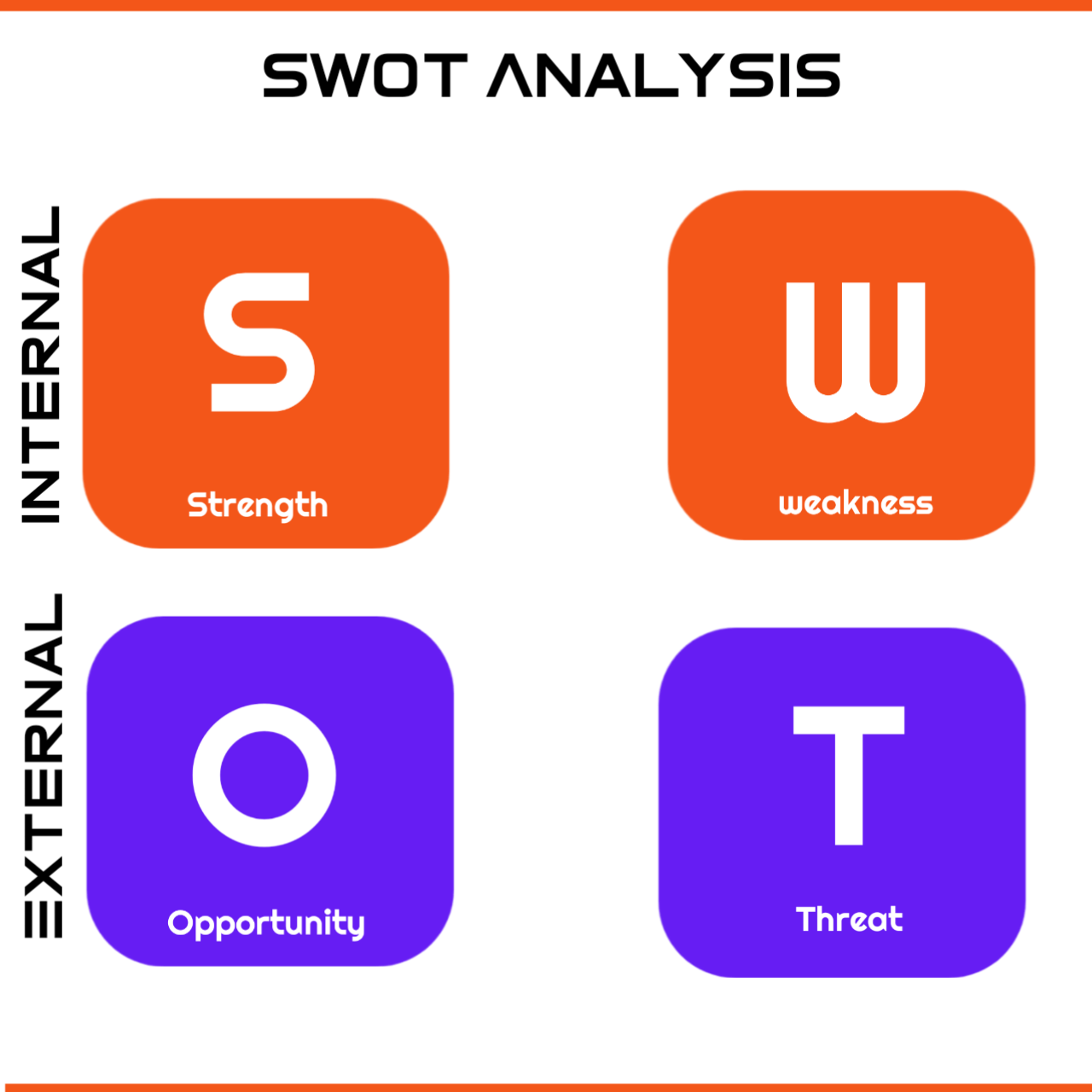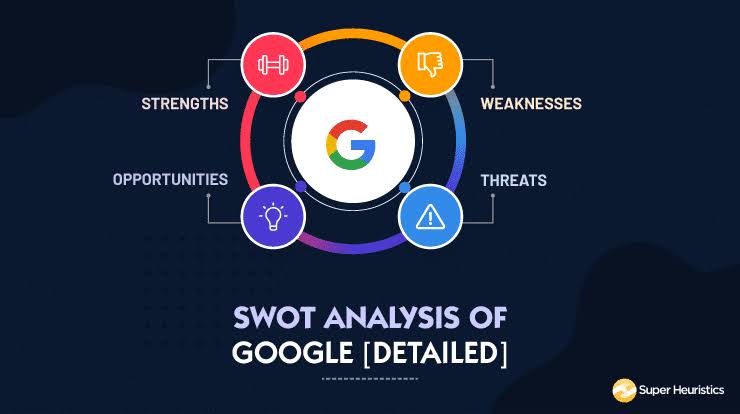Most people, especially entrepreneurs, online marketers, SEO’s, etc usually fall into the mindset that marketing strategy is simple, steady and they know it all. While this might be true it’s not certain. Research has shown severally that marketing strategies change regularly. Because marketing strategies change from time to time, businesses are prone to make changes, via some effective analysis. One of these analyses is the “SWOT Analysis”. Without much ado, In this blog post, we’re going to take an Ultimate Guide to SWOT analysis with example.
Contents
What is Swot Analysis?

SWOT is an analytical approach aimed at evaluating an organization’s loopholes and developing a strategic plan to outrun its competitors. SWOT is an acronym for Strengths, Weaknesses, Opportunities, and Threats
Swot analysis suggests that a business strategic plan should be made based on an internal and an external factors (influence/environment). By which, the internal factors are the strengths and weaknesses of a business while the external factors are the opportunities and threats of such an organization. These factors (internal and external) should be favorable to the company’s objective, as well as the company’s current and future expectations.
Swot analysis is not restricted to any particular business level as it avails to both new and existing organizations. Existing businesses can use a SWOT analysis in developing a working strategy to measure up with the changing business environment. A SWOT analysis should also be used as part of the planning process for new businesses.
The primary goal of a SWOT analysis is aimed at developing a dominant business strategy, by assuring that you’ve deemed your business strengths and weakness as well as the potential opportunities and threats it faces in the marketplace.
In a SWOT analysis, information is to be made from real-time accurate data to keep the analysis accurate. Beliefs pre-conceived or gray areas should also be avoided.
Swot Analysis Elements/ Components

As we said earlier, SWOT is an acronym for four business parameters. These parameters are commonly called the Swot Analysis Element. Swot analysis elements Include; the strengths, weaknesses, opportunities, and threats of every business.
The element, strengths, and weaknesses are used to evaluate the internal factors of the business while Opportunities and threats are used to evaluate how favorable the business is to its external factors.
Strengths
This is an internal factor of a business that makes it stand out from its competition. For instance, an organization’s wide experience of management, highly qualified staff, large market share, and better-advanced technology is referred to as its strength.
In simple terms, the strengths of an organization are things that it does particularly well; in a way that distinguishes you from its competitors.
- What distinguishes us from the competition?
- What are our resources?
- What do we do best?
- Which of our products are proving to be successful?
These are all questions relating to the SWOT analysis, strength.
The strengths of any organization are a crucial part of that organization and should be well noted.
Weakness
This is also an internal factor that places the company or project at a disadvantage in comparison to others. A company’s lack of qualified staff, little experience, old/ archaic technology, small market share, low product quality are all possible weaknesses of a business.
As much as the weakness of an organization might not be an intriguing fact to anyone, it’s ideal you provide honest and accurate reports on the SWOT element, Weakness.
Opportunities
These are external environmental factors that the business or project can actually take advantage of. Opportunities may include high demand for your products or services, little competition in the industry, and favorable legal conditions. If an organization sees an opportunity, it can buy a small, financially stable company in the same industry to strengthen its position in the current market and expand into new target markets. Similarly, tariff reductions may provide an opportunity for a company to expand its market share by exporting its products to a new market.
Threats
These are environmental factors that have the potential to wreak havoc on the business or project. low demand for your products/services, high competition, unfavorable economic law, presence of a monopolist on the market can be referred to as a threat to the business.
In essence, a threat in a SWOT context is seen as an external body that can negatively affect your business progress.
Use Of a Swot Analysis

Swot analysis is not only limited to a profit-seeking organization; rather it is used variably by individuals, profit and non-profit organizations, governmental units, etc. It may be used in the decision-making of the desired objective or pre-crisis planning and preventive crisis management. SWOT analysis may also be used in creating a recommendation during a viability study/survey.
Before deciding on a new business strategy, it is ideal that you conduct a SWOT Analysis to assess your organization’s current position and determine what seems to be working well for you and what doesn’t. Consider your organization’s objectives and how you plan to get there, and what obstacles might stand in your way.
How To Write A Good Swot Analysis

Rather single-person-based, a SWOT analysis should be best conducted by a group of people with different perspectives and stakes in your company to get the most accurate, complete, and objective results. Useful information can be provided from the Managements, sales, customer service, and even customers.
SWOT analysis is somewhat similar to brainstorming. Suggestions and Ideas should be comprehensively generated by different groups of people, as earlier said.
In a situation where SWOT analysis is conducted for a large organization, workers of such organization should be directed to give their suggested ideas and opinions after 5-10 minutes of brainstorming. In most cases, it is ideal for such workers to be given a notebook/pad. This will result in the production of unique ideas and opinions, hence preventing groupthink and ensuring that all voices are heard. Make sure to gather ideas and opinions as much as you can. You can then group similar random ideas, rank them (maybe using a voting system; where you rank top-rated suggestions), and then you can now prioritize the list of ideas.
When following this process, make sure to generate ideas exclusively for each of the quadrants of your SWOT analysis: Strengths, Weaknesses, Opportunities, and Threats.
Questions Templates For Swot Analysis

Strength
- What distinguishes us from the competition?
- What are our resources?
- Which of our products are proving to be successful?
Weakness
- How can we do better?
- What products aren’t performing as well as they should?
- What are the areas where we are short on resources?
- Are there a lack of skilled laborers?
Opportunities
- What opportunities can you take advantage of in our industry?
- What Is the public’s perception of your company?
- What technology can we use to improve?
- Is your company’s product worth gaining a sponsorship?
- Are there changes that can positively impact your company’s progress?
Threats
- What new regulations are posing a threat to your operations?
- What do your competitors excel at?
- What consumer trends are posing a threat to your business?
- Do you have potential competitors?
How to Use Swot Analysis
Before taking any actions on your SWOT Analysis, it is ideal that you assess your organization based on the analysis. Before building a new strategy, find out what’s working well for the organization (strength), what is not working (weakness), where you want to attain (opportunity) and what is stopping you (threat).
After assessing your business, then move over to the strategy-building stage – establish your authority, boost your weaker areas, head off any threats, and exploit every opportunity.
Look at your company calendar with your action list in hand and start marking goals (or milestones) on it. What do you hope to achieve in the coming calendar quarters (or months)?
Swot Analysis With Examples
1. Google Swot Analysis

Strength
King Of the search engine
Google is without a doubt the undisputed king of the online search engine world.
Indomitable
No competitor has even come close to challenging its position, let alone gaining market share in search engines, until now.
Search engine queries
On average, this powerful brand processes over 40,000 search queries per second, which equates to roughly 3.5 billion searches per day. It is the largest source of traffic and has a significant advantage over competitors such as Bing, Yahoo, and Baidu.
Adaptability
Google is adapted to both mobile, pc and Android devices, placing it in a position to directly compete with Apple’s iPhone.
Weakness
Privacy
Many experts have chastised Google for its excessive reliance on privacy, particularly when it comes to hiding information about algorithms.
Bad Pricing Strategy
Google raised the price of its YouTube TV subscription from $49.99 to $64.99 per month on June 30, 2020. The $15 increase (30%) reflects the rising cost of content, according to Google, but critics argue that the increment is ridiculous. Most streaming services, such as Netflix, Disney+, and Peacock, charge between $5 and $15 per month and offer more content than YouTube’s 80 TV channels. Because of the price increase, Google may lose the majority of its 2 million YouTube subscribers.
Google’s business model is heavily reliant on advertising, with ads accounting for more than 85% of the company’s revenue. This means that any revenue decline would be extremely costly to the company (literally as well as metaphorically). The point is that, in addition to its current business model, which is based solely on ad revenues, Google needs to develop a more robust business model that includes e-commerce and mobile commerce.
Opportunities
- Non-Advertising Business Models Diversification – As previously stated, the company must diversify into non-ad revenue streams to remain profitable, and current indications suggest that it is doing so, as evidenced by its push toward commercial transactions through its numerous sites such as Google Books, Google Maps, and so on.
Threats
- Social Media competitor. – The rise of social media has posed a serious threat to Google’s dominance in the internet world, and the company will need to play a winning hand to deal with the growing number of features available on Facebook and Twitter.
2. Netflix Swot Analysis

Strength
- Reputation – Netflix has built a strong brand and has become a household name by replacing some of the most popular television shows. In recent years, the company has grown at an exponential rate.
- Globality – Netflix is available in many Southeast Asian countries and has a global presence. It has given them a competitive advantage in an ever-changing market.
- Originality – Netflix’s original films and television shows provide plenty of opportunities for aspiring filmmakers. The platform’s mode of content is enjoyed by the audience as their own original content.
Weaknesses
- Inadequate Copyrights – Netflix does not own the majority of its content, which has a negative impact on the company. After a few years, the rights obtained from other studios expire, and the content appears on other websites.
- Growing Debt – Netflix distributes its diverse content in a number of countries around the world, which necessitates significant financial resources. To fund new content, Netflix keeps increasing its long-term debt. Netflix had $14.17 billion in debt as of April 2020, with plans to raise another $1 billion through a debt offering. A significant flaw is the annual increase in debt.
Opportunities
- Low-Cost Mobile Streaming Option – In order to entice,retain subscribers and compete with their rivals in the international market, Netflix should thonk of offering a low-cost mobile streaming option. In India, Netflix has already been trying a low-cost mobile-only service that costs only $3 per month. It can expand this lower-cost option globally to compete more successfully against lower-cost competitors such as Disney+, Apple+, Peacock, and others.
- Profit from the Ad-Based Model – Adverts bring in billions of dollars for Google, Amazon, Facebook, and other service providers. Netflix’s revenue can be increased by switching to an advertising-based business model.
- Alliances – If Netflix can form alliances with few or many telecom companies to offer bundle products in many regions, it would benefit massively.
Threat
- Market Saturation – In the fourth quarter of 2019, Netflix added 420,000 new subscribers in the United States, falling short of its target of 600,000. The intended number of customers in Canada was 218,000, but only 125,000 were gained. Because the market has reached saturation, North American subscriber growth has slowed for the third quarter in a row. Due to market saturation, Netflix will have a harder time attracting new users in the future.
- Account Hacking – As a result of the shutdown, the number of hacked Netflix user accounts grew dramatically in Q1 and Q2 of 2020. If account hacking continues, disgruntled Netflix customers may flock to other services.






